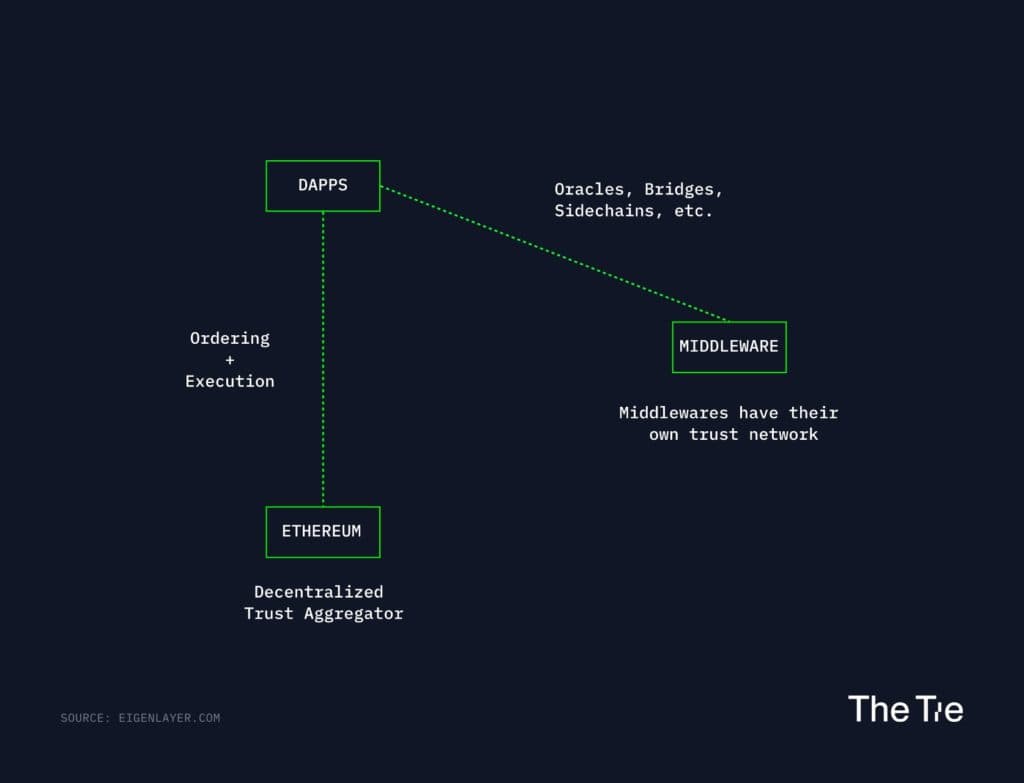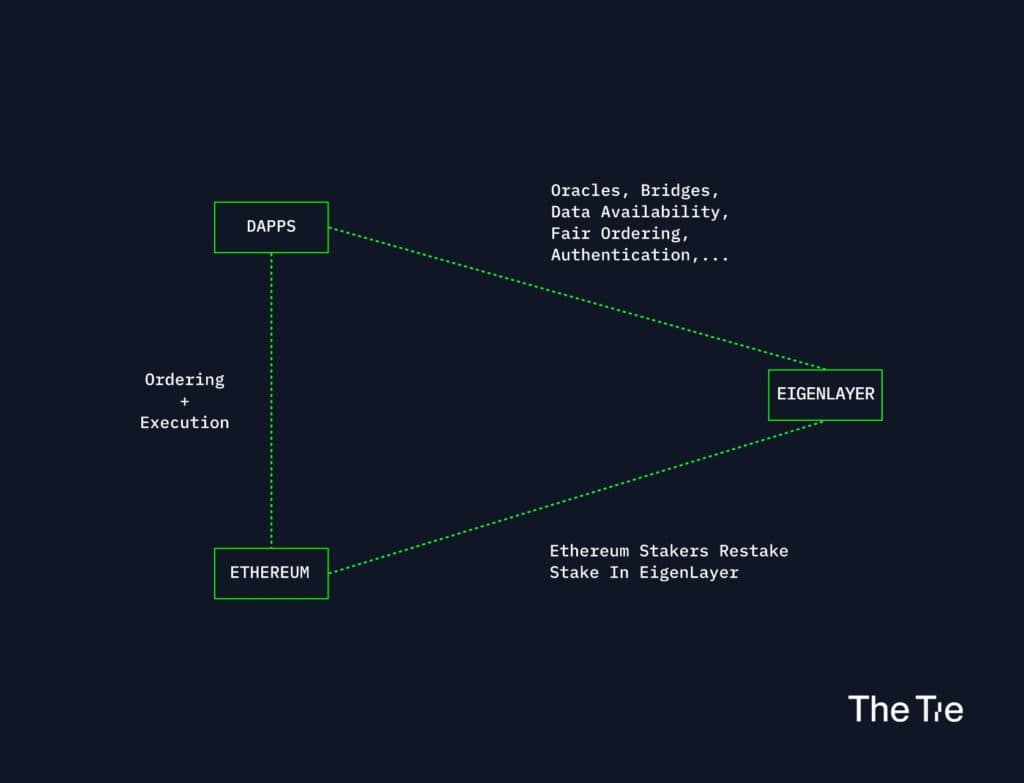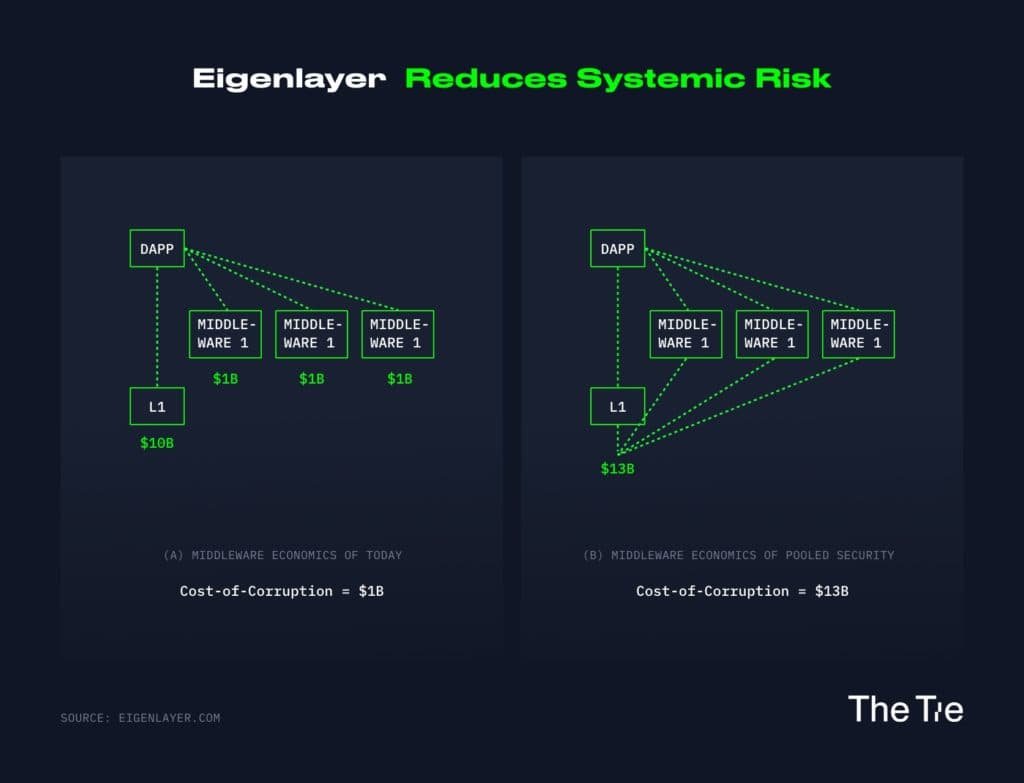Bitcoin pioneered decentralized trust. It was effectively the first monolithically designed blockchain, creating a fixed consensus protocol with limited programmability on top. From there, Ethereum introduced the modular blockchain, enabling the decoupling of trust and innovation; in other words, Ethereum allowed inheritance of its security layer, paving the way for countless innovative protocols to be built on the foundation of Ethereum’s security.
The Tie Research
EigenLayer: The Restaking Collective
Yet, there is a limit to the number of innovations possible on Ethereum. What if someone wanted to develop their own VM or consensus protocol? Currently, a developer would have to build an alternative Layer One (e.g. Cosmos, Avalanche). This leads to fragmentation of trust and development. Furthermore, creating middleware on Ethereum requires enormous amounts of startup capital. Decentralized Applications (dApps) suffer alongside, as they rely on these middleware to operate. It's easy to see how this fractured system of trust presents a real barrier to innovation.
EigenLayer 101
EigenLayer is pitched as a general-purpose marketplace for decentralized trust built on Ethereum. Essentially, introducing a method of internalizing modularity by redirecting trust within the Ethereum ecosystem. The core value proposition behind EigenLayer lies in its “restaking” service and Eigen data availability (EigenDA).

In order to fully extract the benefits of the Ethereum trust layer, EigenLayer breaks it down into 3 distinct aspects:
- Economic Trust
- Decentralized Trust
- Ethereum Validator Commits

Restaking enables the reuse of economic security without incurring additional cost to the staker. This level of economic trust is secured via slashing enforcement. Slashing may seem reminiscent of fraud proofs in the way network security is enforced. The key difference is the result in latency. For instance, a light client bridge’s input (i.e.: NEAR’s Rainbow Bridge) on EigenLayer would act without any latency, given enough amount is staked. The input claim would initially be assumed correct (similar to optimistic rollups) and be subject to slashing, if violations are discovered. A low/no latency bridge, enabled by EigenLayer, is critical to the multi-chain future foreseen by many.
Decentralized trust is key to ensuring collusion of nodes does not occur. In EigenLayer, decentralized trust is inherited from a subset of validators (homebrew or RocketPool), creating a decentralized set on stakers on EigenLayer. Services on EigenLayer can further restrict conditions by enabling a subjective oracle to only allow maximally decentralized nodes.
By combining economic trust and decentralized trust, new services can be created. Enter EigenDA. Eigen Data Availability uses a dual quorum model, where one quorum is run by a subset of Ethereum stakers and the other by Rocket Pool stakers. This model combines the notion of slashing with the idea that collusion amongst nodes should not exist. By employing existing ETH validators and stake, EigenDA has a clear advantage over other data availability chains like Celestia. It can more quickly create a sizable validator network. EigenDA is not a consensus layer, hence it will be less expensive and have a greater throughput than Celestia. By outsourcing consensus, EigenDA’s use-cases are specialized to rollup attestations, allowing for decentralized rollup sequencers, as discussed earlier.
Restaking Benefits & Slashing Risk
Restaking involves taking locked staked Ethereum, and staking it on middleware/dApps, subjecting it to greater slashing conditions. By restaking, validators are providing additional validation services, like oracles, bridges, data-availability, while remaining on the same validator network. This allows programmability of the distributed system itself, allowing for accelerated development within the ecosystem.
In addition, restaking enables zero marginal cost of capital for middleware, as restaking relies on the inherent $200 billion or so in staked Ethereum. Capital is pooled together across middleware/dApps through restaking, making capital efficiency as high as possible. dApps build, in part, with middleware, taking advantage of the shared core trust that Ethereum provides. If successful, Ethereum’s value proposition will grow, leading to increased yield for stakers.
EigenLayer is a series of smart contracts built on top of Ethereum. These contracts allow stakers to opt in to provide services, or restake. Restaking is a mechanism by which stakers obtain additional yield, while subjecting themselves to greater risk via increased potential of having their stake slashed.

The dominant cost in a proof of stake system is capital. Restaking represents the amortization of this cost across many applications, rather than single-use capital in the security layer. The crypto-economics of restaking inherits the base layer’s staking economics, with yield set by the middleware.
This system of not having to rely on tokenization to secure a network will prove to be colossal for the development of Ethereum and middleware/dapps. Now, rather than relying on mercenary capital, existing ETH capital can be used to secure middleware products, eliminating the ebb-and-flow of price action that spawn from ill-conceived tokenomics, often leading to promising projects imploding.

In the event that a governance procedure is used to affirm or reverse a slash before it is implemented, EigenLayer may experience network delays (especially in early days). The security level that validators set for themselves is determined by the applications they execute, with the set of applications to stake carefully considered. A vulnerability in an application that is used by a large portion of stakers might have catastrophic consequences for Ethereum, and result in the loss of a very large percentage of the total ETH supply. As such, careful governance considerations of slashing must be made.
EigenLayer’s Advantages
The most valuable commodity in crypto is blockspace. Blockspace is priced based on how close one is to the blocklimit, which is determined based on the resources available to the weakest node/staker of the network. As a result, stakers with additional resources will take their capital and find another ecosystem to stake on, creating a big opportunity cost the Ethereum network. This unbalanced spread of resources in Ethereum is called staker heterogeneity. EigenLayer aims to leverage staker heterogeneity through restaking, allowing for projects like rollups to have immense performance boosts.
EigenLayer has the potential to enable a quick decision-making form of governance for the Ethereum protocol. Protocols today have to make a tradeoff between agility of response and level of democracy when it comes to designing a governance model. The ability to respond quickly enough to design changes to respond to an event, in traditional protocols, comes with the risk of centralization and lack of democratic governance. EigenLayer tackles this challenge completely in Ethereum. Ethereum represents a credibly neutral, democratically governed layer. This layer is responsible for basic consensus and execution. On top of Ethereum is EigenLayer, representing an open market for stakers to compete for providing services, i.e., restaking.
MEV
Outsourcing of block building to third party builders can often lead to unintended block content. For example, a builder may censor certain transactions.
EigenLayer’s restaking mechanism allows for partial block actions. Validators can sign on to create a part of the block themselves, and leave the rest for the block builder. In this instance, MEV-boost relays store the builder transaction, while sending the merkle root of the transaction to the validator. While there is still some reliance on a centralized relay, validators maintain a backup of the blocks they can propose, if anything were to happen.
Additionally, with the use of EigenDA, trusted relays can be eliminated entirely. In this case, builders send their portion of the block to the validator quorum, such that no node can access any information of the block; this is called secret sharing. The quorum nodes will sign the secret share and return it to the builder, who will attach a bid and send it to the proposer. The proposer selects the highest bidder and signed the header, sending it back to the quorum to release the secret shares to the proposer, who can now re-assemble the builder portion of the block.
This may seem a bit convoluted, but essentially allows the proposer to build a part of the block themselves. This mitages censorship issues, while decentralizing the MEV-boost infrastructure and eliminating the need for trusted relays.
Conclusion
Building on Ethereum’s foundations, EigenLayer enables a new era of innovation. Concepts like anti-MEV fair ordering layers and zk-bridges are now possible directly on Ethereum.
Layer 2s like Mantle, have already begun building on EigenLayer as well. By rerouting trust inside the Ethereum ecosystem, EigenLayer proposes a unique technique for internalizing modularity, enabling development on Ethereum to increase by orders of magnitude.
This report is for informational purposes only and is not investment or trading advice. The views and opinions expressed in this report are exclusively those of the author, and do not necessarily reflect the views or positions of The TIE Inc. The Author may be holding the cryptocurrencies or using the strategies mentioned in this report. You are fully responsible for any decisions you make; the TIE Inc. is not liable for any loss or damage caused by reliance on information provided. For investment advice, please consult a registered investment advisor
Sign up to receive an email when we release a new post